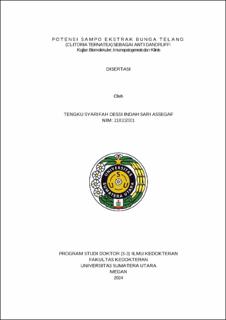Potensi Sampo Ekstrak Bunga Telang (Clitoria Ternatea) sebagai Anti Dandruff: Kajian Biomolekuler, Imunopatogenesis dan Klinis
Potential of Butterfly Pea Flower (Clitoria Ternatea) Extract Shampoo as Anti Dandruff: Biomolecular, Immunopathogenesis and Clinical Studies

Date
2024Author
Assegaf, Tengku Syarifah Dessi Indah Sari
Advisor(s)
Jusuf, Nelva Karmila
Pane, Yunita Sari
Rusda, Muhammad
Metadata
Show full item recordAbstract
Introduction: Dandruff is a scalp disorder characterized by the presence of scales on the scalp and hair shafts accompanied by minimal inflammation and itching. The pathogenesis of dandruff is still a mystery, excessive growth of Malassezia sp., disintegration of epidermis, inflammation and increased sebum levels are the main pathogenesis. Dandruff can affect the quality of life. Dandruff treatment is still challenging because the disease often recurs after treatment is stopped. Clitoria ternatea is known to have antifungal, anti-inflammatory, anti-epidermal disruption and anti-sebocyte ingredients found in secondary metabolites, namely phenols, flavonoids, steroids, alkaloids, tannins and anthocyanins. Kaempferol, Clitorin, Delphinin 3-0-ß-glycoside (anthocyanin), Myricetin 3-glycoside, Quercetin 3-glocoside, Kaempferol 3-glocoside are part of the flavonoid class which have antifungal effects.
Objective: To determine the potential of butterfly pea flower extract (Clitoria ternatea) as anti-dandruff.
Method: The in-vitro test was done using the disk diffusion method to determine the MIC of Clitoria ternatea extract against Malassezia sp.. MIC will be used as shampoo concentration. Tests on the scalp of dandruff patients (in-vivo) were determined using a pre-experimental study with a pre-test and post-test design on 37 dandruff patients who received treatment with Clitoria ternatea 20% shampoo and 33 dandruff patients who received Ketoconazole 2% shampoo. Quantitative RT PCR examination (to assess Malassezia sp. DNA expression, relative expression of plakoglobin mRNA, and relative expression of IL-8 mRNA), sebum level examination and dandruff score were determined before treatment and 4 weeks after treatment. Side effects and level of satisfaction with shampoo use were recorded.
Results: In-vitro tests showed that the MIC of Clitoria ternatea extract against Malassezia sp. was 20% with diameter inhibition zone 7.1 mm. The in-vivo test showed a significant decrease in the DNA expression of Malassezia., the relative expression of plakoglobin mRNA, the relative expression of IL-8 mRNA, sebum levels and dandruff scores in Clitoria ternatea 20% and Ketoconazole 2% shampoo groups. Comparison of delta expression, sebum levels and dandruff scores of both shampoos shows that Clitoria ternatea 20% shampoo was more potent as an antisebocyte while Ketoconazole 2% shampoo was more potent as an anti-Malassezia sp.. There were no significant differences between the groups as anti-plakoglobin, anti-IL-8 and dandruff scores. There were more side effects of using ketoconazole 2% shampoo than Clitoria ternatea 20% shampoo. The level of satisfaction with using shampoo is the same (satisfied).
Conclusion: Butterfly pea extract shampoo (Clitoria ternatea) has anti-dandruff effects based on biomolecular, immunopathogenesis and clinical studies.
Collections
- Doctoral Dissertations [185]
